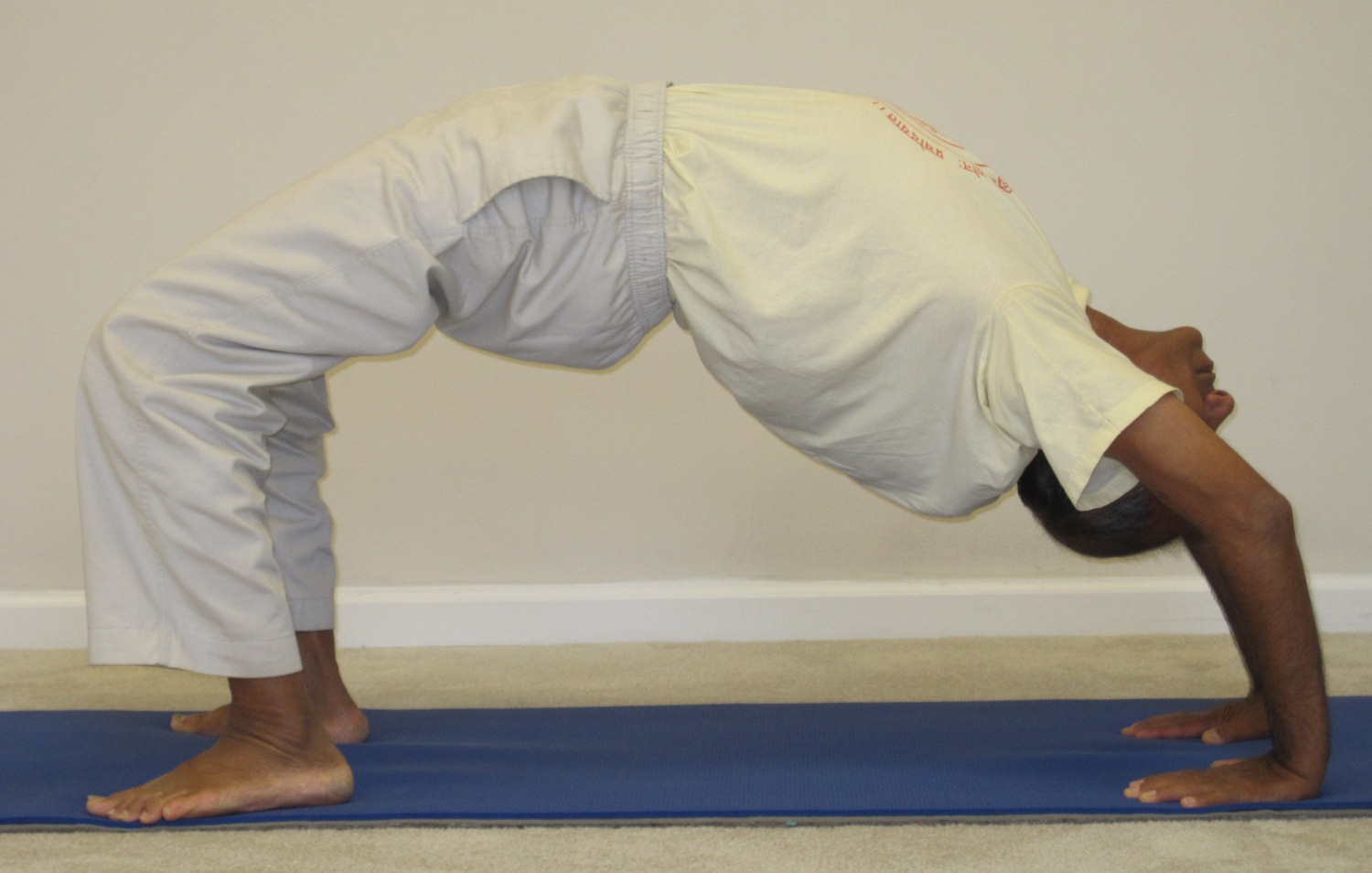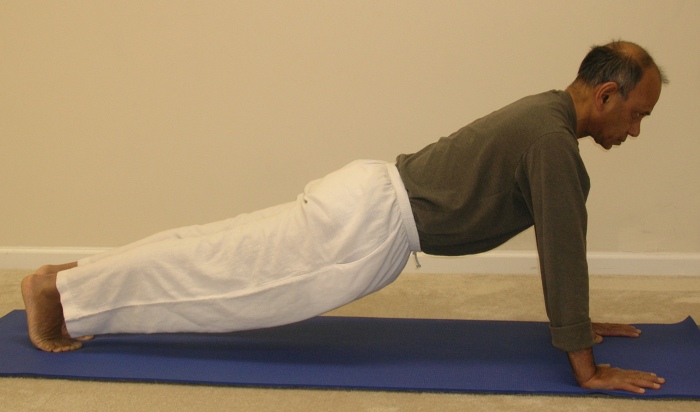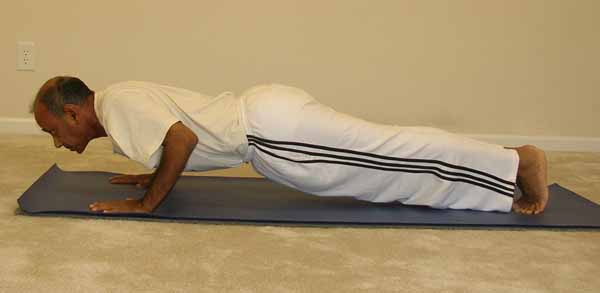 Chakrasana (Wheel Pose)
Chakrasana (Wheel Pose)Chakrasana – चक्रासन – (Wheel Pose), also known as the Urdhva Dhanurasana – ऊर्ध्व धनुरासन – (Upward Bow Pose), is a challenging pose which has tremendous benefits for the strength and suppleness of the spine. In the final position it looks like an inverted bow or a semi-circle – hence the two common names for the pose.
 Dandasana (Plank Pose)
Dandasana (Plank Pose)This is an intermediate level pose and requires proper technique and adequate strength in the wrists, arms and shoulders, as well as the legs, to get into the final position. Some of the poses that will help you develop the necessary skills for this pose are the Dandasana (plank pose) and the Chaturanga-dandasana (four-limbed staff pose).
 Chaturanga (Four-limbed Staff Pose)
Chaturanga (Four-limbed Staff Pose)Due to my recent shoulder surgery, I am unable to practice this asana for the time being. I am hoping that with my regular yoga practice and periodical physical therapy, I will soon regain my strength and flexibility in the arms and shoulders to be able to practice and enjoy the benefits of Chakrasana.
Step-by-step
- Lie flat on your back, feet comfortably apart.
- Bend the knees and place the feet flat on the floor. Try to bring the heels close to your buttocks.
- Bending the elbows, place your palms under your shoulders with the fingers pointing towards the feet. Try to keep the elbows shoulder-width apart.
- Inhale and push the palms into the floor. Slowly, try to lift your shoulders and head off the floor.
- Press your feet firmly into the floor, while inhaling lift your buttocks off the floor. Keeping the pressure with the palms and the feet onto the ground, try to roll the spine off the floor to form a semi-circular arch or a wheel.
- In the final position, make an effort to keep your legs and arms as straight as possible so the hips and chest remain lifted up. Look at the wall behind you.
- Breathe normally and hold the pose for 5-7 breaths or whatever duration feels comfortable. While holding the pose:
- Keep the facial muscles, neck muscles relaxed
- The weight of the body should be distributed evenly on the feet and palms. You can do so by shifting the body (not the palms or feet) back and forth to find the right balance.
- Become aware of the openness and expansion of the chest and continue with regular, even breaths.
- To come out of the pose, exhale and slowly, bend your elbows to lower your head, neck and then shoulders to the floor.
- Bend your knees to slowly roll your spine and hips back to the floor.
- Relax in Shavasana (corpse pose) or the Balasana (child pose) for a few moments before continuing with the rest of your yoga routine.
Variation
- In the final position, if you have the needed strength and flexibility, you may attempt lifting one leg up to a vertical position. Repeat with the other leg.
- As a beginner, you may want to get help from a partner who can support your upper torso to help you lift the shoulders and the head off the floor.
Benefits
- The entire front part of the body gets a deep stretch. Openness of the chest helps bring in more fresh supply of oxygen.
- The muscles on the front part of the thighs (quads) and the calves are stretched and strengthened.
- This pose is extremely beneficial for those who sit long hours in front of the desk or computer as they usually hunch over the desk all day long. The backward stretch in the pose will relieve tension or stress from the body and helps in alleviating problems resulting from poor posture.
- This pose helps in toning and strengthening the back muscles.
- It helps brighten your mood and brings about a sense of well-being.
Precautions and Contraindications
- People who suffer from serious spinal column ailments, such as cervical and lumbar spondylitis should avoid practicing this pose.
- Do not push or force yourself into creating an arch in the spine. With practice, the spine will become more flexible and supple.
- Because of the deep arch to the spine, it is best to do a counter pose, such as Matsyasana (Fish pose), Marjarasana (cat and cow pose) or the Balasana (child pose) after practicing Chakrasana, to relieve any strain from the spine.
I would love to hear from you about your own experience with the practice of Chakrasana.
I am trying to practice this pose but I find my arms are not strong enough yet to push up more than an inch off the ground. Is there a pose I can do to strengthen my body so I can do this pose? Thank you very much!
Dear T. Holmes, you may want to try the “upper body strength” routine that I have give on my blog here – http://yogawithsubhash.com/2009/05/22/building-upper-body-strength/. This should help you build strength in your arms, shoulder, core muscles and the chest which should help you with the chakrasana.
Sir,
I have tried chakarasan and i feel no broblem in this asan but i am suffering from nightfall problem and i thonk it increase by this asan. Kindly suggest me the right asan for nightfall and also shold i do chakarasan or not.
Dear Manjeet, I really don’t know if there is any connection between the chakrasana and nightfall or what might be good for it. I am sorry I can’t be of help in this matter.
[…] Strengthen your spine with Chakrasana (Wheel Pose) Chakrasana (Wheel Pose) Chakrasana – चक्रासन – (Wheel Pose),… […]
Dear respected Subhashji,
All your articles are well explained.
I just can’t believe you had shoulder surgery particularly A perfect yogi of you caliber. Hope you are now keeping fine. There is saying in Bhagawat Gita nothing is permanent in this materialistic world it keep changing. Likewise our physical body also keep changing.
May the Almighty Give you good physical and mental health in your endeavour and mission of propagating our ancient treasure of Yoga founded by our great Rishies and seers for the welfare of the humanity.
Regards and best wishes
Ramani
Hello Ramani,
As you rightly said, nothing is permanent and the body, in particular, is very fragile. In my case, I injured my shoulder as a result of a fall while coming down the stairs in my home. That’s what caused the tear in the rotator cuff which was repaired with surgery. In any case, I am no “perfect yogi” as you put it. I am just a student of yoga, still trying to understand various aspects of yoga practice at deeper levels. Thank you so much for your good wishes. With all your kind wishes, I am recovering gradually and hope to get back to normal functioning soon.
Hello Hari, I am glad you found the article useful. It will be nice if you could share your yoga experience and practice.
Hi,
Thanks for posting an article on chakrasana. Found it very useful.